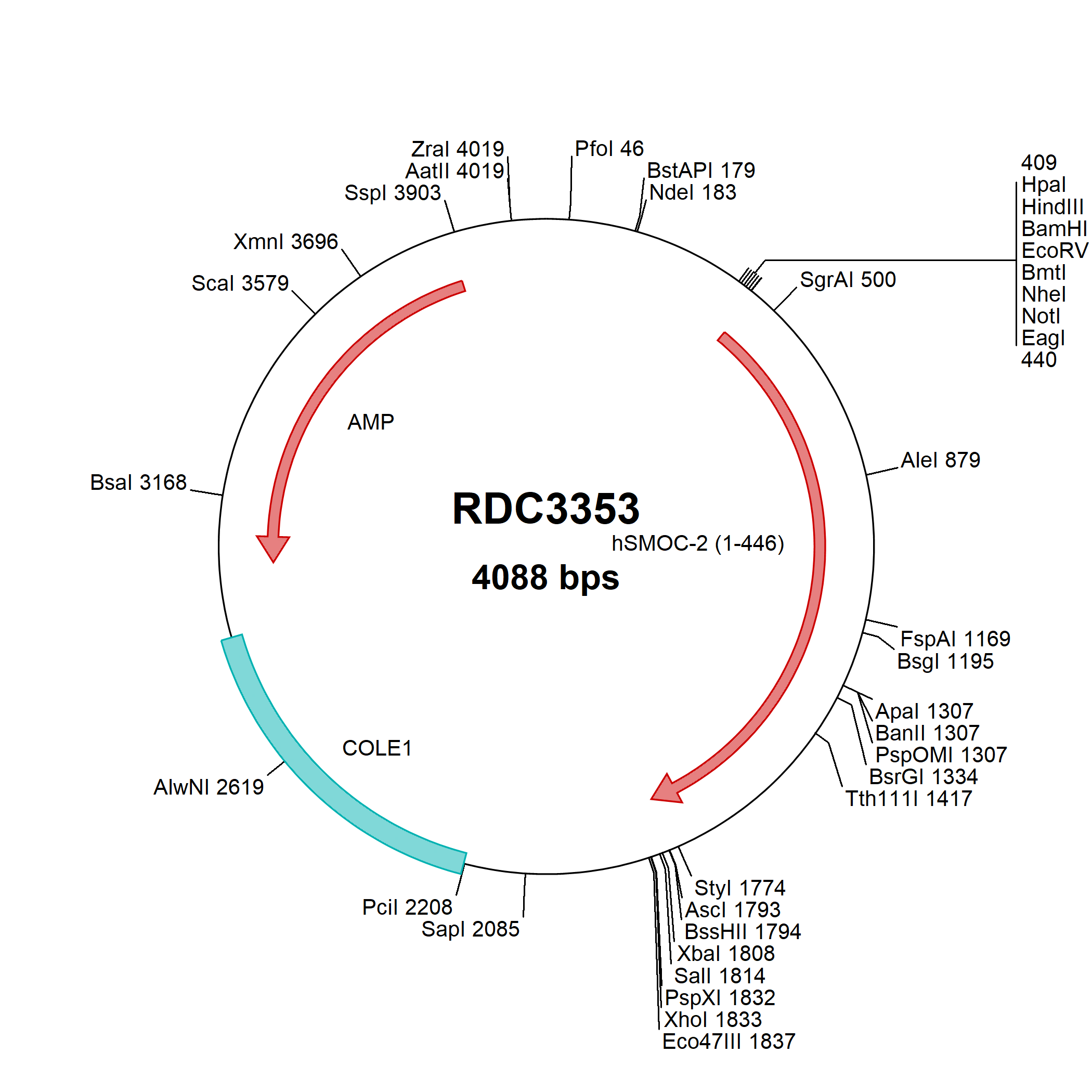SMOC-2 Products
SMOC-2 (secreted, or SPARC-related, modular calcium-binding protein 2), previously called SMAP2 (smooth muscle-associated protein 2), is a 55 kDa glycoprotein that is a member of the SPARC family of matricellular proteins. The human SMOC-2 cDNA encodes 446 amino acids (aa), including a 21 aa signal sequence, a Kazal-like domain (aa 40-84), two thyroglobulin type-1 segments (aa 87-153 and 213-281) and two EF-hand sequences (aa 347-382 and 384-419). Of three splice variants, one shows a 13 aa substitution for aa 442-446, another shows an 11 aa insertion after Thr170, and a third contains both of these variations. Mature human SMOC-2 shares 95%, 95% and 94% aa identity with mouse, rat and canine SMOC-2, respectively. SMOC-2 is widely expressed in the extracellular matrix and appears to have adhesion-related functions. Recombinant bacterially produced human SMOC-1 and SMOC-2 can bind the acute phase protein, C-reactive protein, and the adhesion proteins, fibulin and vitronectin, while keratinocyte SMOC-2 binds integrins alpha V beta 1 and alpha V beta 6. SMOC-2 promotes cell cycle progression by signaling through the integrin-linked kinase (ILK) to upregulate cyclin-D1. When expressed in the endothelial extracellular matrix, it potentiates growth factor-induced angiogenesis. SMOC-2 expression is upregulated during neointima formation, promoting proliferation and migration of vascular smooth muscle. In the skin, it promotes keratinocyte attachment and migration. Since Kazal and thyroglobulin domains are often found in protease inhibitors, SMOC-2 is also proposed to inhibit proteases in the lung and artery.
9 results for "SMOC-2" in Products
9 results for "SMOC-2" in Products
SMOC-2 Products
SMOC-2 (secreted, or SPARC-related, modular calcium-binding protein 2), previously called SMAP2 (smooth muscle-associated protein 2), is a 55 kDa glycoprotein that is a member of the SPARC family of matricellular proteins. The human SMOC-2 cDNA encodes 446 amino acids (aa), including a 21 aa signal sequence, a Kazal-like domain (aa 40-84), two thyroglobulin type-1 segments (aa 87-153 and 213-281) and two EF-hand sequences (aa 347-382 and 384-419). Of three splice variants, one shows a 13 aa substitution for aa 442-446, another shows an 11 aa insertion after Thr170, and a third contains both of these variations. Mature human SMOC-2 shares 95%, 95% and 94% aa identity with mouse, rat and canine SMOC-2, respectively. SMOC-2 is widely expressed in the extracellular matrix and appears to have adhesion-related functions. Recombinant bacterially produced human SMOC-1 and SMOC-2 can bind the acute phase protein, C-reactive protein, and the adhesion proteins, fibulin and vitronectin, while keratinocyte SMOC-2 binds integrins alpha V beta 1 and alpha V beta 6. SMOC-2 promotes cell cycle progression by signaling through the integrin-linked kinase (ILK) to upregulate cyclin-D1. When expressed in the endothelial extracellular matrix, it potentiates growth factor-induced angiogenesis. SMOC-2 expression is upregulated during neointima formation, promoting proliferation and migration of vascular smooth muscle. In the skin, it promotes keratinocyte attachment and migration. Since Kazal and thyroglobulin domains are often found in protease inhibitors, SMOC-2 is also proposed to inhibit proteases in the lung and artery.
| Reactivity: | Human, Mouse |
| Details: | Sheep IgG Polyclonal |
| Applications: | WB |
| Source: | CHO |
| Accession #: | AAH47583 |
| Applications: | BA |
| Reactivity: | Human |
| Details: | Mouse IgG2b Monoclonal Clone #667713 |
| Applications: | IHC |
| Reactivity: | Human, Mouse |
| Details: | Sheep IgG Polyclonal |
| Applications: | WB |
| Source: | NS0 |
| Accession #: | AAH19527 |
| Applications: | BA |
| Reactivity: | Human |
| Details: | Rabbit IgG Polyclonal |
| Applications: | IHC, WB, ELISA |
| Reactivity: | Human |
| Details: | Rabbit IgG Polyclonal |
| Applications: | WB |
| Applications: | WB |





![Immunohistochemistry-Paraffin: SMOC-2 Antibody [NBP1-39788] Immunohistochemistry-Paraffin: SMOC-2 Antibody [NBP1-39788]](https://resources.bio-techne.com/images/products/SMOC-2-Antibody-Immunohistochemistry-Paraffin-NBP1-39788-img0001.jpg)
![Western Blot: SMOC-2 Antibody [NBP2-20425] Western Blot: SMOC-2 Antibody [NBP2-20425]](https://resources.bio-techne.com/images/products/SMOC-2-Antibody-Western-Blot-NBP2-20425-img0002.jpg)
![Western Blot: SMOC-2 Overexpression Lysate [NBL1-16248] Western Blot: SMOC-2 Overexpression Lysate [NBL1-16248]](https://resources.bio-techne.com/images/products/SMOC2-Overexpression-Lysate-Adult-Normal-Western-Blot-NBL1-16248-img0002.jpg)